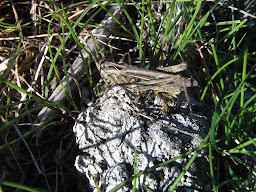Little Owl Treat
The Arnside and Silverdale AONB is one of my favourite areas to explore and despite my many visits there over the years there are still plenty of hidden gems to check out. On a bright but breezy Friday afternoon I met up with one of my North Lancs Wildlife Group friends to explore one such new (to me) corner of the coast. Despite its unprepossessing name, the slag tips - or Warton Sands to sound more polite - at Carnforth are a haven for wildlife. Following the narrow road to its termination overlooking the Keer estuary we set off along the gravelly path passing the stock car racing site and out towards the headland. A small flock of linnets including some males in rich pink summer colours bounced between the saltmarsh and the rocky banking with their colours being matched by the short, rich purple carpet of thyme which stretched in all directions. We headed past a stretch of land fenced-off to protect ground-nesting birds - a female wheatear and some goldfinch in evidence here - and climbed up onto the slag tips.
The weird landscape here, with lumps of iron slag and spoil blending in with the rocky and rugged coastline, are testimony to the Carnforth Iron Works and notwithstanding their industrial origins this is a rich site recolonised by nature, with those hardy specialists rabbits much in evidence scooting into burrows as we passed by. In the blustery conditions, with the wind becoming keener as we ventured onto more exposed terrain, few insects were on the wing but we did spot some tortoiseshell and meadow brown butterflies. The tide wasn't fully in and we ventured down at points onto the shoreline to explore the strand. Three days earlier a high tide had deposited its load and amongst the inevitable human debris (we gathered in some of what we were able to carry) were some nice natural finds including plenty of whelk and dogfish egg cases and a few cuttlefish bones.
The Slag Tips Cuttlefish Bone
On the edge of the tide three shelduck and a pair of oystercatcher were spotted and searching amongst the stones we found lots of sandhoppers and a few large sea slaters, larger maritime cousins of the woodlouse. Perhaps slightly more picturesque we found a patch of yellow horned poppy although the blustery conditions meant the picture below was the best I could manage. We then continued on our way towards the tip of the headland with views across the channel to the RSPB saltmarsh hides and Silverdale and round past Jenny Brown's Point towards Arnside. Closer to hand a female eider bobbed close in to the point and at the end of the walk we spotted seven more of these bulky sea ducks feeding at the mouth of the Keer. We walked back in the more sheltered lee of the rocky headland along the edge of the saltmarsh with freshly-shorn sheep grazing and more rabbits sprinting for cover as we approached. Suddenly two stocky brown birds flew up from beside the path and landed on the rocky bank opposite and in that brief glimpse we realised they were little owls. Once they had landed they blended very well with their surroundings and it was only when they flew up again and perched thirty yards or so further on that we got a reasonable glimpse of one of them, which might well have been a fledged youngster. I managed to get a reasonable enough photo but when I raised my camera again it had vanished! Closer inspection revealed two burrows in the scree where it had been perched and it had clearly nipped down one of them to shelter.
Yellow Horned Poppy Sea Slater
We ended our walk on the saltmarsh where the river Keer trickles its way into the estuary. On the strandline here we spotted a dead gannet but an inspection revealed it didn't have a leg ring. Much more full of life were the jaunty pied wagtails foraging amongst the short grass, which was interspersed in patches with sea pink. Closer to the river and tall stands of rush provided cover for insects including silver Y moth, small skipper and clegs whilst bare patches of gravel and rock beside the path had some mottled grasshoppers. Our objective was short-winged coneheads, a saltmarsh speciality which has spread rapidly along this stretch of coast, but despite best efforts to hear them with a bat detector we had to accept it was probably too breezy and cool for them to be out in force.
Dead Gannet Mottled Grasshopper











Great read as always! Sounds like a beautiful place to walk and see wildlife.
ReplyDelete